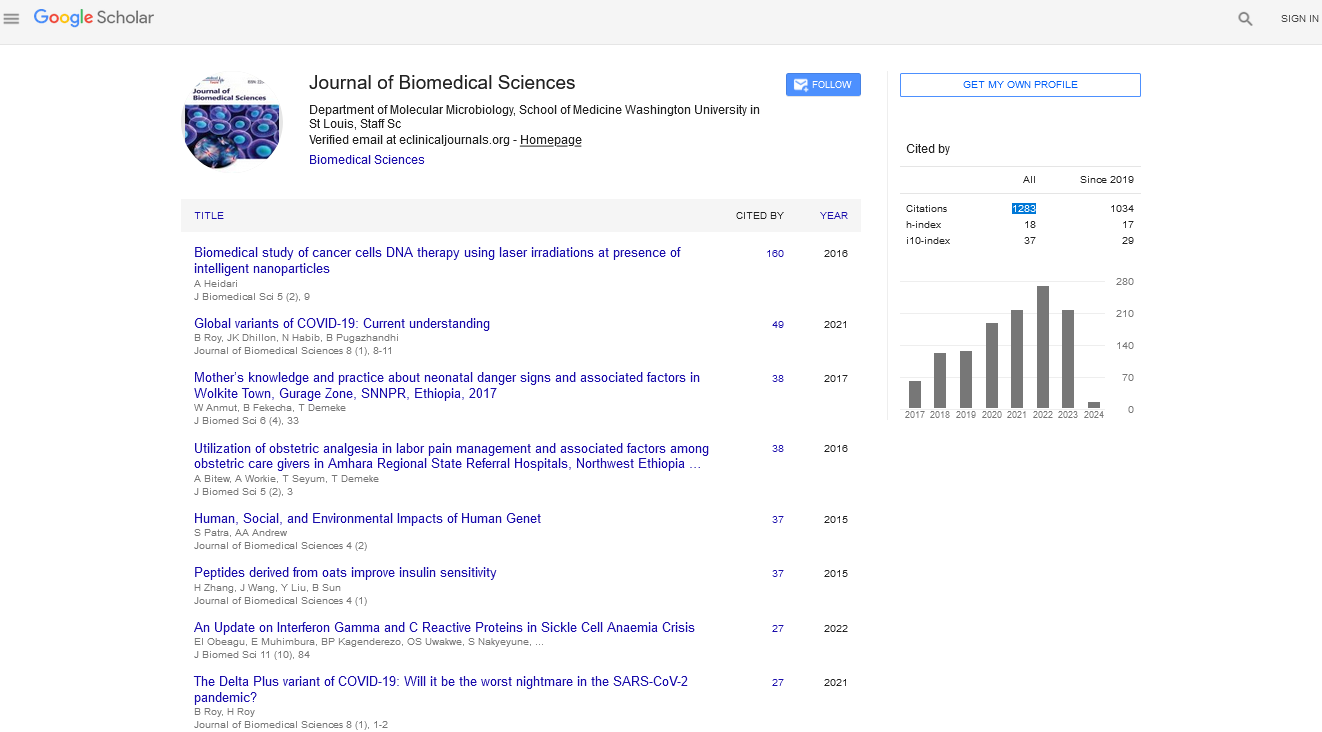Perspective - (2024) Volume 13, Issue 6
Clinical Applications of Biomarkers in Cardiovascular Disease
Marthe Charles*
Department of Biomedical and Molecular Sciences, Queen's University, Kingston, Canada
*Correspondence:
Marthe Charles, Department of Biomedical and Molecular Sciences, Queen's University, Kingston,
Canada,
Email:
Received: 15-Nov-2024, Manuscript No. IPJBS-24-15316;
Editor assigned: 19-Nov-2024, Pre QC No. IPJBS-24-15316 (PQ);
Reviewed: 03-Dec-2024, QC No. IPJBS-24-15316;
Revised: 13-Dec-2024, Manuscript No. IPJBS-24-15316 (R);
Published:
20-Dec-2024
Introduction
Cardiovascular Diseases (CVDs) remain a leading cause of
mortality worldwide, and the need for accurate, early detection
and effective management has never been more pressing.
Biomarkers, molecules that indicate specific biological
conditions, have emerged as essential tools in the detection,
diagnosis, prognosis, and treatment of cardiovascular diseases.
The use of biomarkers has transformed cardiovascular care by
enabling more personalized approaches, improving the accuracy
of diagnoses, and offering insights into disease mechanisms.
Description
Understanding biomarkers in cardiovascular disease
A biomarker is a measurable indicator of a biological state or
condition. In cardiovascular disease, biomarkers may be
proteins, lipids, genes, metabolites, or imaging findings that
reflect a change in heart function, inflammation, or structural
alterations associated with cardiovascular risk. Effective
biomarkers are easily measurable, provide consistent results,
and correlate well with clinical outcomes.
Cardiovascular biomarkers are typically divided into categories
based on their functions in the disease process:
• Diagnostic biomarkers for identifying disease presence.
• Prognostic biomarkers for predicting disease progression or
complications.
• Predictive biomarkers to determine response to treatments.
• Monitoring biomarkers for tracking treatment efficacy and
disease recurrence.
Biomarkers have a wide range of clinical applications, from
screening and diagnosis to guiding therapeutic interventions.
key biomarkers in cardiovascular disease
Several biomarkers are widely used in cardiovascular disease
detection and management. They offer insights into different
aspects of disease mechanisms, such as inflammation, cardiac
muscle injury, and stress on the cardiovascular system.
Troponins: Cardiac troponins (cTnT and cTnI) are proteins
involved in muscle contraction regulation. Elevated troponin levels indicate myocardial injury and are the gold standard for
diagnosing Acute Myocardial Infarction (AMI). Measuring
troponin levels allows healthcare providers to diagnose heart
attacks and monitor damage levels, ensuring timely interventions.
High-sensitivity assays for troponins (hs-cTn) allow for the
detection of even minor cardiac injuries. The ability of hs-cTn to
detect small increases in troponin levels has made it invaluable
in emergency departments, where quick and accurate AMI
diagnosis is essential.
B-type Natriuretic Peptide (BNP) and NT-proBNP: B-type
Natriuretic Peptide (BNP) and its inactive fragment NT-proBNP
are released by the heart in response to increased wall stress,
often due to heart failure. Elevated BNP and NT-proBNP levels
are critical indicators of heart failure, making them useful
diagnostic biomarkers. These peptides are also valuable for
predicting disease severity and guiding treatment decisions, as
higher levels correlate with worsening heart function and
increased mortality risk.
BNP and NT-proBNP levels help distinguish heart failure
from other conditions with similar symptoms, such as
respiratory infections, allowing for appropriate treatment.
C-Reactive Protein (CRP): C-reactive Protein (CRP) is a marker
of inflammation and is commonly elevated in individuals with
cardiovascular disease. High-sensitivity CRP (hs-CRP) assays
measure even low levels of CRP and are used to assess
cardiovascular risk. Elevated hs-CRP levels correlate with an
increased risk of coronary artery disease, myocardial infarction,
and stroke, making it a valuable biomarker for risk stratification.
In primary prevention, hs-CRP is used alongside traditional
risk factors to identify individuals at high risk of CVD, guiding
lifestyle modifications and preventive measures.
Lipid biomarkers: Lipid profiles, including levels of Low-
Density Lipoprotein (LDL), High-Density Lipoprotein (HDL), and
triglycerides, are fundamental to cardiovascular risk assessment.
Elevated LDL levels are associated with an increased risk of
atherosclerosis, while HDL levels are inversely related to
cardiovascular risk. Triglyceride levels provide additional insights
into metabolic syndrome, a condition that raises cardiovascular
disease risk.
Advances in lipidomics have introduced new lipid biomarkers,
such as apolipoproteins A1 and B, which offer a more refined
assessment of lipid-related cardiovascular risk.
Galectin-3: Galectin-3 is a marker of inflammation and fibrosis
associated with heart failure and other cardiovascular
conditions. Elevated galectin-3 levels are linked to worsening
heart failure and increased mortality, making it a valuable
prognostic biomarker. Galectin-3 levels can help stratify patients
based on risk, allowing for more tailored management strategies
in heart failure treatment.
MicroRNAs: MicroRNAs (miRNAs) are small, non-coding RNA
molecules that regulate gene expression. Certain miRNAs are
associated with cardiovascular conditions, making them valuable
as potential biomarkers. For example, miR-1 and miR-133 are
associated with myocardial injury, while miR-208 and miR-499
are linked to heart muscle cells. The use of miRNAs in
cardiovascular disease is still in development, but they offer
promise in diagnostics and risk assessment.
Clinical applications of cardiovascular biomarkers
Biomarkers have several clinical applications in the
management of cardiovascular diseases. Their utility spans from
identifying at-risk individuals to predicting treatment responses,
aiding in personalized medicine approaches.
Early diagnosis and risk stratification: Timely diagnosis of
cardiovascular diseases can significantly improve outcomes.
Biomarkers enable early detection of cardiovascular conditions
before symptoms appear. For instance, measuring hs-CRP and
lipid profiles helps assess cardiovascular risk, identifying
individuals who would benefit from preventive strategies.
In patients presenting with chest pain, biomarkers like
troponins allow for a quick and accurate diagnosis of myocardial
infarction, guiding immediate treatment. Additionally, NTproBNP
levels in patients with shortness of breath help
differentiate heart failure from other causes, facilitating rapid
diagnosis and treatment.
Prognostic assessment: Prognostic biomarkers help predict
disease progression and outcomes, enabling more effective
patient management. For example, elevated NT-proBNP or BNP
levels indicate severe heart failure, correlating with worse
prognosis and higher mortality. Similarly, elevated troponin
levels in stable coronary artery disease suggest an increased risk
of adverse events, such as heart attacks.
Galectin-3 and hs-CRP levels also have prognostic value in
heart failure and coronary artery disease, respectively, helping clinicians predict long-term outcomes and tailor management
plans accordingly.
Therapeutic monitoring and treatment guidance: Biomarkers
play a critical role in monitoring therapeutic responses in
patients undergoing treatment. NT-proBNP levels are used to
assess heart failure treatment effectiveness; a decrease in NTproBNP
levels indicates improved heart function, while persistently
high levels suggest the need for treatment adjustments.
Similarly, lipid biomarkers, such as LDL cholesterol levels,
guide statin therapy for patients with atherosclerosis or high
cholesterol. Regular monitoring of lipid levels ensures patients
are achieving target cholesterol levels, reducing cardiovascular
risk.
Personalized medicine in cardiovascular disease: Biomarkers
facilitate personalized medicine by identifying patients who are
more likely to respond to specific treatments. For example,
patients with elevated LDL levels benefit more from statins,
while individuals with high hs-CRP levels may respond well to
anti-inflammatory therapies. These tailored approaches optimize
treatment efficacy, reducing unnecessary drug exposure and
minimizing side effects.
In addition, genetic biomarkers, such as specific polymorphisms
in genes encoding drug-metabolizing enzymes, can guide
medication selection to reduce adverse effects. Pharmacogenomics
is increasingly used to identify patients who may have adverse
reactions to drugs or who may benefit from alternative dosages,
ensuring safer and more effective treatment.
Conclusion
Biomarkers have become integral to modern cardiovascular
disease management, offering valuable information for
diagnosis, prognosis, and treatment. From traditional markers
like troponins and BNP to emerging biomarkers like microRNAs,
these molecules improve the precision of cardiovascular care,
allowing for earlier detection, risk stratification, and tailored
therapeutic approaches. As research progresses, the discovery of
novel biomarkers will continue to refine cardiovascular medicine,
bringing personalized treatment strategies within reach and
ultimately improving patient outcomes in cardiovascular disease
management.
Citation: Charles M (2024) Clinical Applications of Biomarkers in Cardiovascular Disease. J Biomed Sci Vol:13 No:6





